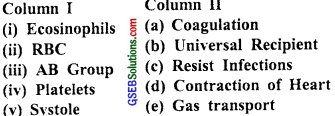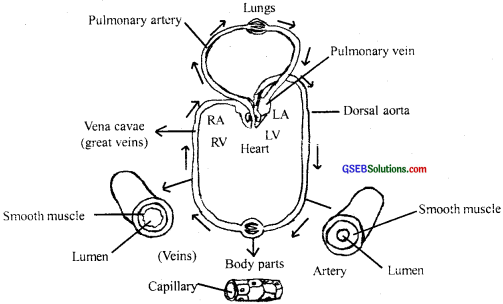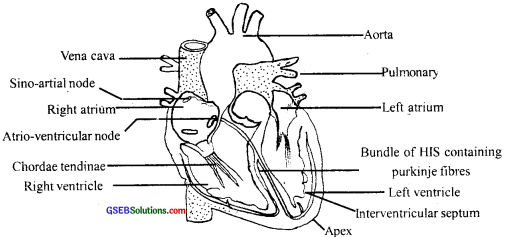Gujarat Board GSEB Textbook Solutions Class 11 Biology Chapter 18 Body Fluids and Circulation Textbook Questions and Answers.
Gujarat Board Textbook Solutions Class 11 Biology Chapter 18 Body Fluids and Circulation
GSEB Class 11 Biology Body Fluids and Circulation Text Book Questions and Answers
Question 1.
Xante the component of the formed elements in the blood and mention one major function of each of them.
Answer:
Erythrocytes, leucocytes and platelets are collectively called formed elements of the blood. Erythrocytes are the red blood cells (RBC). These molecules play a significant role in transport of respiratory gases. Leucocytes are the white blood cells (WBC). There are two main categories of WBCs granulocytes and agranulocytes. Neutrophils, eosinophils and basophils are different types of granulocytes, while lymphocytes and monocytes are the agranulocytes.
Neutrophils and monocytes are phagocytic cells which destroy foreign organisms entering the body. Basophils secrete histamine, serotonin, heparin etc. and are involved in inflammatory reactions. Lymphocytes are responsible for immune responses of the body. Platelets also called thrombocytes,.are cell fragments produced from megakaryocytes. Platelets are responsible for clotting or coagulation of blood.
![]()
Question 2.
What is the importance of plasma proteins?
Answer:
Fibrinogen, globulins, and albumins are the major plasma proteins.
- Fibrinogens are needed for clotting or coagulation of blood.
- Globulins primary is involved in defense mechanisms of the body.
- The albumins help in osmotic balance.
Question 3.
Match column I with column II:

Answer:
- (c) Resist Infections
- (e) Gas transport
- (b) Universal Recipient
- (a) Coagulation
- (d) Contraction of Heart
Question 4.
Why do we consider blood as a connective tissue?
Answer:
Connective tissue usually is involved in structure and support and derived from mesoderm. Blood is considered as connective tissue because:
- It has the same origin (mesodermal) as do the other connective tissues.
- blood connects the body systems together bringing the needed oxygen, nutrients, hormones, and other important molecules and removing the waste.
![]()
Question 5.
What is the difference between lymph and blood?
Answer:
Differences between the lymph and blood
Lymph:
Lymph is a colorless fluid containing specialized lymphocytes that are responsible for the immune responses of the body. Lymph is also an important carrier for nutrients, hormones, etc. Fats are absorbed through lymph in the lacteals present in the intestinal villi.
Blood:
Blood is made up of a fluid medium called plasma in which float three types of blood cells, called red blood cells, white blood cells, and blood platelets. Blood cells are manufactured in the bone marrow.
Question 6.
What is meant by double circulation? What is its significance?
Answer:
Double circulation refers to the separate systems of pulmonary circulation and systemic circulation. The deoxygenated blood pumped into the pulmonary artery is passed on to the lungs from where the oxygenated blood is carried by the pulmonary veins into the left atrium. This pathway constitutes pulmonary circulation.
The oxygenated blood entering the aorta is carried by arteries and capillaries to the tissues from where the deoxygenated blood is collected by a system of venules, veins, and vena cava and emptied to the right atrium. This is the systemic circulation.
The systemic circulation is responsible for providing nutrients, O2, and other essential substances to the tissues and taking away CO2 and other harmful substances for elimination.

![]()
Question 7.
Write the differences between:
- Blood and lymph
- The open and closed system of circulation
- Systole and diastole
- P-wave and T-wave
Answer:
(1) Difference between the blood and lymph
Lymph:
Lymph is a colorless fluid containing specialized lymphocytes that are responsible for the immune responses of the body. Lymph is also an important carrier for nutrients, hormones, etc. Fats are absorbed through lymph in the lacteals present in the intestinal villi.
Blood:
Blood is made up of a fluid medium called plasma in which float three types of blood cells, called red blood cells, white blood cells, and blood platelets. Blood cells are manufactured in the bone marrow.
(2) Difference between Open circulatory system and Closed circulatory system
Open circulatory system:
The open circulatory system is present in arthropods and mollusks in which blood pumped by the heart passes through large vessels into open spaces or body cavities called sinuses.
Closed circulatory system:
Annelids and chordates have a closed circulatory system in which the blood pumped by the heart is always circulated through a closed network of blood vessels. This pattern is considered to be more advantageous as the flow of fluid could be more precisely regulated.
(3) Difference between Systole and Diastole
Systole:
Ventricular systole increases the ventricular pressure causing the closure of tricuspid and bicuspid values due to attempted backflow of blood into the atria. As the ventricular pressure increases fur¬ther, the semilunar valve guarding the pulmonary artery (right side) and the aorta (left side) is forced open, allowing the blood in the ventricles to flow through these ves¬sels into the circulatory pathways. Systolic pressure is higher and occurs during ventricular contraction.
Diastole:
The ventricles now relax (ventricular diastole) and the ventricular pressure falls causing the closure of semilunar valves which prevent the backflow of blood into the ventricles. As the ventricular pressure declines further, the tricuspid and bicuspid valves are pushed open by the pressure in the atria exerted by the blood which was being emptied into them by the veins. Diastolic pressure is lower and occurs during ventricular expansion.
(4) Difference between P-wave and T-wave
P-wave:
The P-wave represents the electrical excitation (or depolarization) of the atria, which leads to the contraction of both the atria
T-wave:
The T-wave represents the return of the ventricles from an excited to a normal state (repolarisation). The end of the T-wave marks the end of the systole.
![]()
Question 8.
Describe the evolutionary change in the pattern of heart among the vertebrates.
Answer:
All vertebrates possess a muscular chambered heart. Fishes have a two-chambered heart with an atrium and a ventricle. Amphibians and reptiles except crocodiles have a 3-chambered heart with two atria and a single ventricle, whereas crocodiles, birds, and mammals possess a four-chambered heart with two atria and two ventricles. In fishes, the heart pumps out deoxygenated blood which is oxygenated by the gills and supplied to the body parts from where deoxygenated blood is returned to the heart (single circulation).
In amphibians and reptiles, the left atrium receives oxygenated blood from the gills/ lungs/skin and the right atrium gets the deoxygenated blood from other body parts. However, they get mixed up in the single ventricle which pumps out mixed blood (incomplete double circulation). In birds and mammals, oxygenated and deoxygenated blood received by the left and right atria respectively passes on to the ventricles of the same sides. The ventricles pump out without any mixing up i.e., two separate circulatory pathways are present in these organisms, hence these animals have double circulation.
Question 9.
Why do we call our heart myogenic?
Answer:
Because normal activities of the heart are regulated intrinsically, i. e., auto regulated by specialized muscles (nodal tissue), hence the heart is called myogenic. A special neural center in the medulla oblongata can moderate cardiac function through the autonomic nervous system (ANS). Neural signals through the sympathetic ventricular contraction and thereby the cardiac output. On the other hand, parasympathetic neural signals (another component of ANS). decrease the rate of heartbeat, speed of conduction of action potential, and thereby the cardiac output. Adrenal medullary hormones can also increase cardiac output.
![]()
Question 10.
The Sinoatrial node is called the pacemaker of our heart. Why?
Answer:
Because sinoatrial node (SAN) can generate a maximum number of action potentials ie. 70-75 per minute and is responsible for initiating and maintaining the rhythmic contractile activity of the heart. Therefore, it is called the pacemaker i.e., our heart normally beats 70-75 times in a minute (average 72 beats/mt)/

The entire heart is made of cardiac musculature. The walls of ventricles are much thicker than that of the atria. A specialized cardiac musculature called the nodal tissue is also distributed in the heart (Fig 18.2). A patch of this tissue is present in the right upper comer of the right atrium called the sino-atrial node (SAN).
Question 11.
What is the significance of the atrioventricular node and atrioventricular bundle in the functioning of the heart?
Answer:
The heartbeat initiated by Sinoatrial node is picked up by the Atrioventricular node and the action potential is conducted to the ventricular side. From the AV node, the heartbeat is transmitted to the AV bundle (Bundle of HiS) which transmits it through the entire ventricular musculature.
![]()
Question 12.
Define cardiac cycle and cardiac output.
Answer:
This sequential event in the heart which is cyclically repeated is called the cardiac cycle and it consists of systole and diastole of both the atria and ventricles. The heart beats 72 times per minute i.e. that many cardiac cycles are performed per minute. From this, it could be deduced that the duration of a cardiac cycle is 0.8 seconds. During a cardiac cycle, each ventricle pumps out approximately 70ml of blood which is called the stroke volume. The stroke volume multiplied by the heart rate (no. of beats per min.) gives the cardiac output.
Therefore, the cardiac output can be defined as the volume of blood pumped out by each ventricle per minute and averages 5000ml or 5 liters in a healthy individual. We have the ability to alter the stroke volume as well as the heart rate and thereby the cardiac output. For example, the cardiac output of an athlete will be much higher than that of an ordinary man.
Question 13.
Explain heart sounds.
Answer:
During each cardiac cycle, two prominent sounds lub and dub are heard. The first heart sound (lub) is associated with the closure of the tricuspid and bicuspid valves which extends for 0.16 – 0.9 sec. The second heart sound (dub) is associated with the closure of the semilunar valves and extends for 0.10 sec.
![]()
Question 14.
Draw a standard ECG and explain the different segments in it.
Answer:
Diagrammatic presentation of a standard ECG:
Each peak in the ECG is identified with a letter from P to T that corresponds to a specific electrical activity of the heart. The P – wave represents the electrical excitation (or depolarization) of the atria which leads to contraction of both the atria.
The QRS complex represents the depolarization of the ventricles, which initiates the ventricular contraction. The contraction starts shortly after Q and marks the beginning of the systole.
The T – wave represents the return of the ventricles from an excited to a normal state (repolarisation). The end of the T – wave marks the end of the systole.
